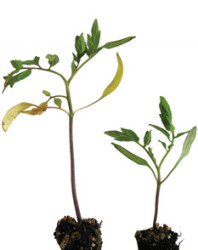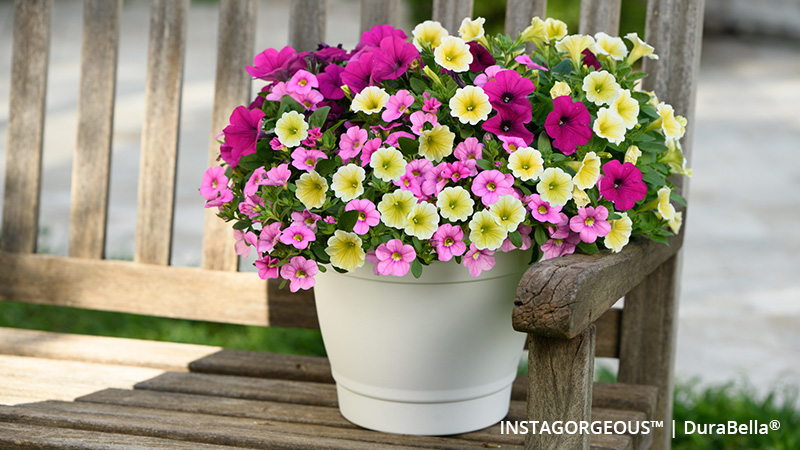An Eye On Phosoporus Nutrition

Ask a vegetable transplant grower: What is a high-quality transplant? The response invariably is not the largest plant, but a plant grown in a controlled manner. The growth characteristics of desired transplants go like this:
– Transplants should be small, so the grower can grow thousands and thousands more in the same space and time.
– Transplants should be compact and sturdy, so they are easy to ship. Large, spindly transplants are unwieldy and get bruised during shipping.
– Transplants should have good roots. A root ball formed by good roots makes it easy to pull or push transplants from transplant trays during transplanting.
– Transplants should have a high root-to-shoot ratio. A larger root system, relative to shoot, supports the plant better after transplanting in the field.
– Transplants should have somewhat smaller leaves. Large leaves lose more water, thus the transplant is more prone to wilting in the field, where dry winds or high temperatures dry the soil rapidly.
– Transplants should have thick stems so they don’t fall over in the trays or lodge later in the field due to wind or rain.
– Of course, transplants should look green and healthy.
Now, take a peek at the growing media, rather its formula, used for growing transplants. Often these growing mixes have high phosphorus, like 2 to 3 pounds of triple superphosphate per cubic yard of mix. Such rates result in the mix having a phosphorus concentration of more than 10 times the normal levels of 20-30 ppm. Considering the effects of phosphorus, there is disconnect between what kind of transplant is desired and what is being practiced. High rates of phosphorus are not cheap either; they amount to 10 percent of the mix cost. High rates of phosphorus in the mix result in runoff pollution, too.
Since transplant growing came into practice, types of greenhouse styles, transplant trays and irrigation systems have been evolving. But progress in transplant nutrition seems to be slow. A little understanding of how phosphorus acts in the soil, as well as in the plant, will help you regulate transplant growth. Good growing requires acquisition of new knowledge while examining existing beliefs. Let’s examine some of these beliefs.
Isn’t Phosphorus A Starter Fertilizer?
Phosphorus as a starter-fertilizer concept seems to have come from professional cousins to vegetable transplant growers: field farmers. In the field, high-phosphorus fertilizers are applied at the start of planting and are indeed useful there. Why? Most mineral soils have aluminum and iron. Aluminum and iron react with phosphorus and precipitate and render most of the applied phosphorus insoluble and not available to the plants immediately. A great portion of the applied phosphorus ends up fixed by these soils. High levels of phosphorus are thus needed to satisfy the soil and then have some available for the plants.
Also, early plantings in cool spring weather experience phosphorus deficiency: You may have seen purpling of leaves. In cold temperatures, phosphorus solubility decreases and phosphorus moves less in the soil. Plant root growth is also slow. To cope with these conditions, farmers apply high rates of phosphorus as a starter fertilizer, so at least some of it is accessible to the small root system of young plants.
But vegetable transplants are not grown in mineral soils or in cold temperatures. Vegetable transplants are grown in soilless, peat-lite mixes and in temperature-controlled greenhouses. Peat or other components of mixes contain little aluminum and iron. Whatever phosphorus you apply in these conditions is immediately available to the plants. High phosphorus levels, as in field farming, are not needed for growing in peat mixes, either at the start or later.
Doesn’t Phosphorus Boost Root Growth?
As much as the marketing brochures of fertilizer companies want you to believe, high phosphorus boosting root growth is non-science nonsense. In fact, the opposite is true: High levels of phosphorus reduce root growth. Whenever phosphorus or nitrogen (not potassium though) supply increases, the ratio of root to shoot decreases.
When there is less phosphorus, the plant restricts its shoot growth more than root growth. Plants divert more of their resources to the roots, so roots can grow farther to find phosphorus. If you want a higher root-to-shoot ratio, you want to provide lower phosphorus or nitrogen. Low phosphorus also stimulates root hairs, which absorb much of the nutrients and water.
What’s The Harm In Giving High Phosphorus?
To start, high phosphorus or any high nutrient level increases salt levels in the growing media. High salt levels in the media delay and decrease seed germination through reduced water availability. High salt levels also burn the emerging tender roots of seedlings.
In greenhouses, where temperatures are favorable for growth, if phosphorus and other nutrients are non-limiting, plants grow to their maximum potential and become large. However, we know such large, extreme, unwieldy growth is undesirable for transplants.
Large transplants with large leaves become crowded in the transplant tray and shade neighboring transplants. This shading causes the transplants to stretch in order to find light. Increase in plant stem diameter is related to increased light. So, if transplants are less crowded, they will have more light and thus thicker stems and less prone to lodging.
When the levels of phosphorus are in excess of a plant’s needs, plants accumulate the excess phosphorus, up to a limit. The accumulated phosphorus, however, is put into a storage pool in the plant cells and is not used for current growth. If there is still too much phosphorus, then there will be toxicity.
High levels of phosphorus react with iron and precipitate and reduce iron availability, both outside in the growing media and inside the plant, increasing the incidence of leaf chlorosis.
High levels of phosphorus and other nutrients produce transplants that have more water but less dry matter. Low nutrient concentrations produce plants that have high dry matter. Transplants that have high dry matter are more resistant to shock and recover better when they go from greenhouse shelter to the open field.
Low Phosphorus Makes Transplants Compact
Plant stem elongation is sensitive to phosphorus. Therefore, a good way to control stem elongation is controlling phosphorus levels.
High levels of phosphorus make transplants too tall and not easy to manage. An effect of slight phosphorus deficiency is shorter stems. We can use this effect for height control of plants by lowering the levels of phosphorus and producing plants whose stems or internodes are shorter.
With low phosphorus levels, the number of nodes on a transplant seems to remain the same. There is slight reduction in leaf area. This reduction in leaf area helps transplants suffer less from drought stress later in the field.
What About The Appearance Of Low-Phosphorus Plants?
Leaves slightly deficient in phosphorus are darker green, because early phosphorus deficiency doesn’t affect the green pigment chlorophyll. Chlorophyll content often increases. This effect is unlike the deficiency of nitrogen, the other nutrient that can be used to control plant growth. Nitrogen deficiency reduces leaf chlorophyll, and plants appear light green or yellow. So, unlike with nitrogen stress, good plant appearance can be sustained with low phosphorus levels.
Also, unlike nitrogen deficiency, which inhibits photosynthesis, the process by which the plant builds its foods like starch and sugars, phosphorus deficiency does not decrease photosynthesis as much as shoot growth. Starch continues to be produced. Because there is a decrease in growth, starch produced is accumulated. Starch accumulation in a transplant is a type of hardening. Immediately after transplanting in the field, the transplant can draw its food from these reserves and establish faster.
What About The Field Performance Of The Transplants Grown With High Phosphorus?
Phosphorus is mobile in the plant, meaning it moves from leaves where there is sufficient phosphorus to leaves where phosphorus is deficient. If transplants consumed and accumulated excess phosphorus and if phosphorus is limiting in the transplanted field, the transplant uses the accumulated phosphorus for growth. However, the amount of phosphorus accumulated in the small transplant would be little compared to what the growing plant in the field needs.
Generally, any effects of different fertilizer treatments on the transplant start diminishing in the field as the season progresses. Plant growth in the field is affected more by fertilization in the field rather than by fertilization during the transplant production.
What’s The Best Way To Provide Phosphorus To Transplants?
With abundant phosphorus and other nutrients and water, transplants become very large. We want to limit the abundant nutrient supply so we can have the desired characteristics in the transplants.
With high pre-plant phosphorus levels already in the mix, you have less flexibility to control transplant growth, especially from early on. Transplants grow rapidly and become lanky even before the emergence of leaves. By starting with a mix with low phosphorus levels and supplying phosphorus through liquid feed, you would have the flexibility to control the transplant growth.
During growing, suppose your farmer says his field won’t be ready, or he wouldn’t have labor, or weather is turning bad and requests you to hold back the transplants. Now you have to slow the growth. With phosphorus in the liquid feed, you have the flexibility to slow plant growth, using low phosphorus fertilizer formulas.
With phosphorus in the liquid feed, if you want, you can shift to a high phosphorus feed just before finishing and load the transplant with phosphorus. This way the final transplant is not large but a transplant whose growth was checked and now has high phosphorus levels.
Remember the aim is to maintain low phosphorus levels and obtain the desired growth. Though most plants are responsive and high phosphorus supply usually brings deficient plants out of deficiency, you don’t want to retard the phosphorus supply and the transplant growth too much. Remember, phosphorus is essential for plant growth.










